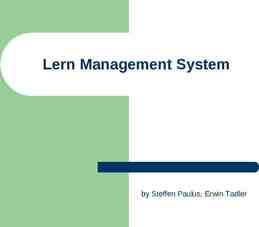Galaxies and the Universe CHAPTER 30
22 Slides2.84 MB
Galaxies and the Universe CHAPTER 30
Which galaxy do we live in? Milky Way Planet Solar System Galaxy Local Group Galaxy Cluser Supercluster Universe
Shape of the Milky Way The Milky Way is a spiral galaxy It is thought that Supermassive Black Holes are at the center of most galaxies, Including the Milky Way Because we are in it, we cannot see what it looks like. Thought to look something like this one. Can use radio waves to do almost an MRI of the galaxy This is due to Radio Waves long wavelength.
Formation and Evolution of the Milky Way Formed 13.2 billion years ago Shortly after the Big Bang Galaxy began as a spherical cloud in space Rotation formed this into a disk-like shape
Dark Matter Galaxies show evidence that there is an unknown substance, which is called Dark Matter Made of a form of subatomic particle that interacts weakly with other matter
Types of Galaxies Spiral galaxies Barred Spiral Spiral Elliptical galaxies
The Local Group A small cluster of galaxies, including the Milky Way Roughly 2 million ly across About 40 known members Milky Way and Andromeda are the largest
Groups of galaxies Large clusters (hundreds or thousands of galaxies) Galaxies can collide
Supercluster Larger cluster of galaxies
The Universe is expanding Most galaxies have redshifts, meaning that they are moving away from us Additionally, evidence shows that the further from us a galaxy is, the faster it is going. Hubble’s Law This shows us that the Universe is expanding in all directions.
Universe’s current age 13.7 billion years
Cosmology The study of the Universe and its evolution Based on Einstein’s Theory of General Relativity Lots and lots of math
The Big Bang Theory The theory that the universe began tiny and has been expanding since Scientific Theory explanation with lots of evidence Not an explosion There was “nothing” before the Big Bang, because time itself did not yet exist Time cannot exist without matter
What is the shape of the Universe? The Universe is experiencing 2 opposite forces The momentum of the outward expansion The gravitational forces of the matter in the universe What will happen will depend on which of these forces is stronger
Open Universe Expansion will never stop This would happen if expansion gravity
Closed Universe If gravity expansion, the universe will begin to contract Will eventually collapse in on itself Big Crunch
Flat Universe If gravity expansion, the rate of expansion will stop, and it will drift slowly apart forever.
How to determine which it is? We need to know the Universe’s density We don’t know this value Most cosmologists think that the data is pointing to a flat universe Good news? Nope Will result in distant galaxies and stars disappearing, stars supernovaing and becoming black holes, and single atoms being stretched across lightyears. When will this happen? ?
Cosmic Background Radiation Electromagnetic Radiation left over from the Big Bang If you turn a TV to a static station, about 1% of the “snow” is caused by the cosmic background radiation
Dark Matter and Dark Energy Cosmologists estimate that the Universe is 21% Dark Matter 75% Dark Energy Practically nothing is known about these materials. Scientists know that they exist, but still do not know what they are or how they work.



























